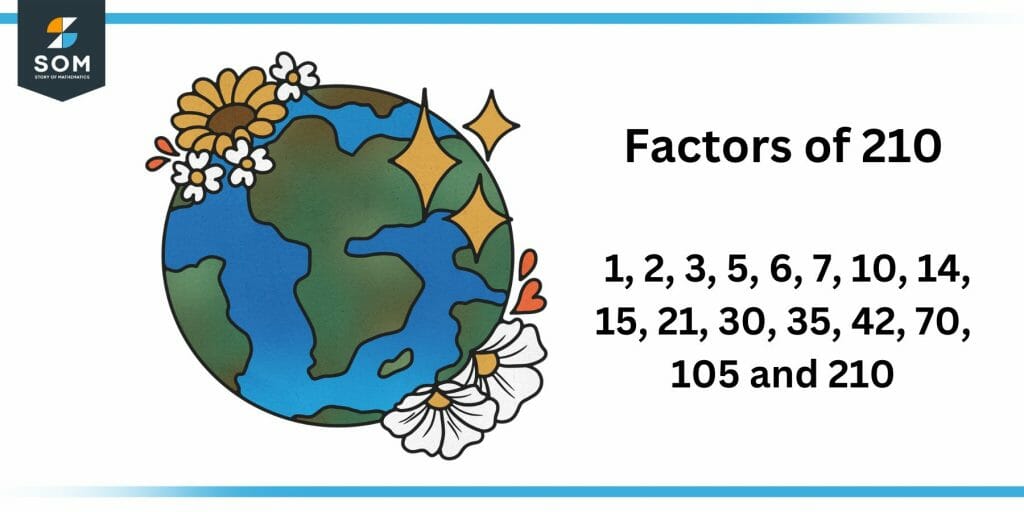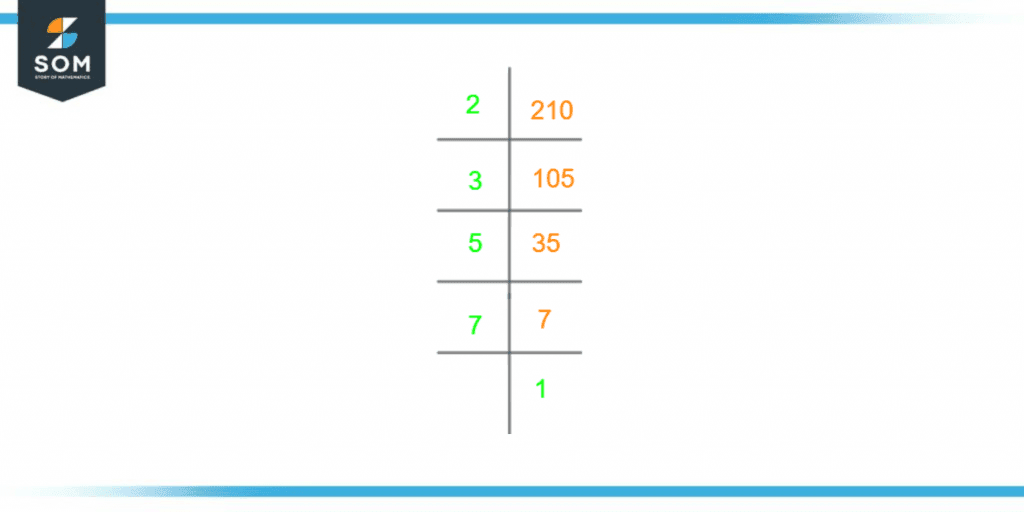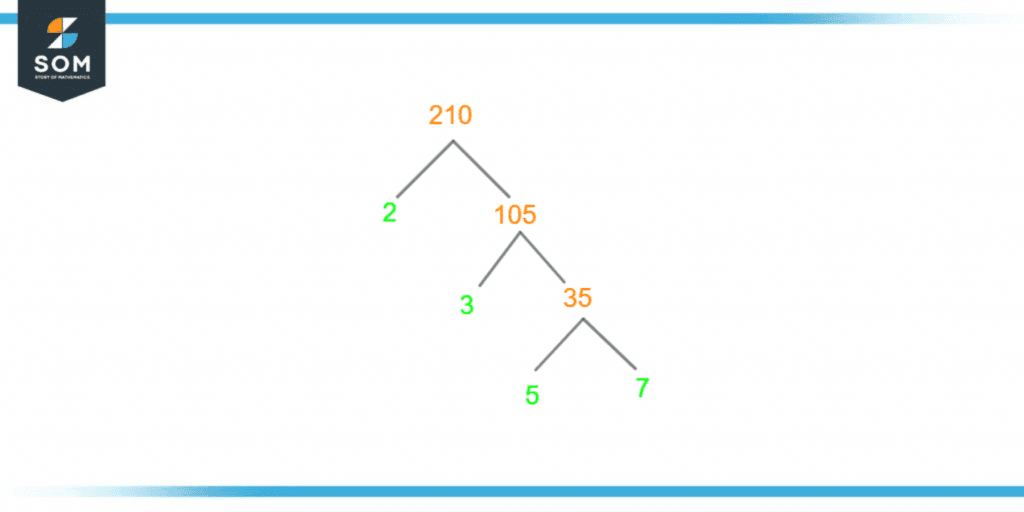JUMP TO TOPIC
Factors of 210: Prime Factorization, Methods, Tree, and Examples
The factors of 210 are all the numbers that can evenly or thoroughly divide 210. Two things happen when a factor divides 210: a whole number quotient is produced, and the remainder is always equal to zero.
Figure 1 – All possible Factors of 210
What Are the Factors of 210?
The factors of 210 are 1, 2, 3, 5, 6, 7, 10, 14, 15, 21, 30, 35, 42, 70, 105 and 210. 210 has a large number of factors; hence it is a composite number. The total number of factors is 16.How To Calculate the Factors of 210?
The most effective way to calculate the factors of 210 is the division method. But before proceeding with any of the factor-finding techniques, it is imperative that we find the range of the factors of 210.The range can be calculated as follows:The final point in the range of factors of 210 = $\frac{210}{ 2}$
The final point in the range of factors of 210 = 105
So we now know that the range of factors of 210 will always start from 1 and end at 105. All the factors possible for 210 MUST lie within this range.Once we have confirmed the range of factors, we can proceed with the division method. Getting back to the details of this method, we know that we have a divisor, a dividend, and a quotient in the division. If the divisor divides the dividend in the method that a quotient with no decimal part is produced, then this divisor must be a factor of the dividend. This is written as:Dividend / Divisor = Quotient
So if the quotient is a whole number, then it means that this division resulted in a zero remainder. With a thorough understanding of this division method, we can now get to applying it on 210:\[ \frac{210}{ 2} = 105 \]\[ \frac{210}{ 3} = 70\]\[ \frac{210}{ 5} = 42 \]\[ \frac{210}{ 6} = 35 \]\[ \frac{210}{ 7} = 30 \]\[ \frac{210}{ 10} = 21\]\[ \frac{210}{ 14} = 15 \]\[ \frac{210}{ 15} = 14 \]\[ \frac{210}{ 21} = 10 \]\[ \frac{210}{ 30} = 7 \]\[ \frac{210 }{ 35} = 6 \]\[ \frac{210}{ 42} = 5 \]\[ \frac{210}{ 70} = 3 \]\[ \frac{210}{ 105} = 2 \]\[ \frac{210}{ 210} = 1 \]\[ \frac{210}{1 }= 210 \]This is the division method performed on 210 to find its prime factors; all the divisors in the division of 210 shown above are factors because they produce a quotient with no decimal part. Therefore, the factors of 210 according to the division method are: 1, 2, 3, 5, 6, 7, 10, 14, 15, 21, 30, 35, 42, 70, 105 and 210. Factors of 210 through division method: 1, 2, 3, 5, 6, 7, 10, 14, 15, 21, 30, 35, 42, 70, 105 and 210.Factors of 210 by Prime Factorization
Prime factorization is another tool for calculating factors of any number. This tool uses the functionality of prime numbers to find only the prime factors of 210. Prime factors of 210 are at their roots, prime numbers that can perform even or complete division of 210. If you multiply the prime factors of 210, this multiplication will also result in an answer equal to 210. This makes the prime factors of any number distinct from each other.The prime factors can be calculated by dividing 210 with the smallest possible divisor in the first step. The quotient output at this step will then be used as the dividend in the next step of prime factorization. To understand this more clearly, look below for the prime factorization of 210:210 $\div$ 2 = 105
105 $\div$ 3 = 35
35 $\div$ 5 = 7
7 $\div$ 7 = 1
We can observe that only prime numbers were used to divide the dividend. Another observation is that 2, 3, 5, and 7 always give a whole number quotient when divided by 210, 105, 35, and 7, respectively. This shows us that 2, 3, 5, and 7 are, in fact, the prime factors of 210. Therefore, the prime factors of 210 are:The prime factors of 210 are 2, 3, 5, and 7.To look at how we can explain the entire procedure above through an equation, we use the multiplication signs:Prime factorization of 210 = 2 x 3 x 5 x 7
This is also shown below in figure 1:
Figure 2 – Prime Factorization of 210
Factor Tree of 210
The factor tree of 210 is just another way of expressing its prime factorization. What makes a factor tree different from other methods is that it uses the symbolism drawn from the branches of a tree extending to its roots. The division method is differentiated from the prime factorization through the mathematical operations involved. Factor trees are differentiated from the rest based on the mode of solution it represents because we do not perform mathematical operations. Still, we use the branches of a tree to show the prime factors of 210.In a factor tree of 210, we will see its prime factors at its roots. We call them roots because the tree can not be branched out further once all its branches have reached prime numbers at their ends. This entire theory can be better understood through an actual diagram of a factor tree that has been attached below as figure 2:
Figure 3 – Factor Tree of 210
Factors of 210 in Pairs
The factor pairs of 210 represent a unique pair among its factors that will always multiply to answer 210. This makes these factor pairs, not just any meaningless arrangement. One factor pair can represent the number by itself without needing any other number.If the condition of mutual multiplication yielding the original number is fulfilled, then any two factors which satisfy this condition can be called a factor pair. To find out the factor pairs of 210, we need first to recall the factors:Factors of 210 = 1, 2, 3, 5, 6, 7, 10, 14, 15, 21, 30, 35, 42, 70, 105 and 210. There are a total of 16 factors, meaning we should expect 8-factor pairs if the number is not a perfect square. If we encounter a perfect square, the factor pairs will always include an extra factor pair for the square root. Anyhow, for 210, the factor pairs are mentioned below. These are the only pairs that can represent 210 when multiplied together:Factor pairs of 210 = (1, 210), (2, 105), (3, 70), (5, 42), (6, 35), (7, 30), (10, 21), (14, 15)The 16 factors of 210 paired up to make 8-factor pairs. We formerly talked about how factor pairs can be positive and negative. The negative factor pairs exist because when we multiply two negative numbers, they give back a positive number. So the negative factor pairs of 210 are:Negative Factor pairs of 210 = (-1, -210), (-2, -105), (-3, -70), (-5, -42), (-6, -35), (-7, -30), (-10, -21), (-14, -15)Factors of 210 Solved Examples
The following examples reveal how we can apply the theory learned in the former sections to our advantage.Example 1
Solve for the common factors of 210 and 10.Solution
To find out the common factors between 210 and 10, let us first write down the factors of each:Factors of 210 = 1, 2, 3, 5, 6, 7, 10, 14, 15, 21, 30, 35, 42, 70, 105 and 210. Similarly, the factors of 10 are:Factors of 10 = 1, 2, 5, and 10.To identify the common factors between 210 and 10, we need to look at both factors. We start with identifying that 10 has fewer factors, so it is better to use it as a standard for comparing factors. We start with one and notice that both 10 and 210 have it. Then we look at the next factor of 10, which is 2; 210 also has that as a factor. In this manner, we check for all factors and realize four common ones exist. These common factors are:The common factors between 210 and 10 are 1, 2, 5, and 10.Example 2
Find out the average of the factors of 210.Solution
The factors of 210 are:Factors of 210 = 1, 2, 3, 5, 6, 7, 10, 14, 15, 21, 30, 35, 42, 70, 105 and 210. The average of these factors can be calculated through the formula:Average = Sum of all factors of 210/ Total number of factors
Average =( 1 + 2 + 3 + 5 + 6 + 7 + 10 + 14 + 15 + 21 + 30 + 35 + 42 + 70 + 105 + 210 ) / 16
Average = 576 / 16
Average = 36
Therefore, the average of the factors of 210 is 36.All images/mathematical drawings are created with GeoGebra.